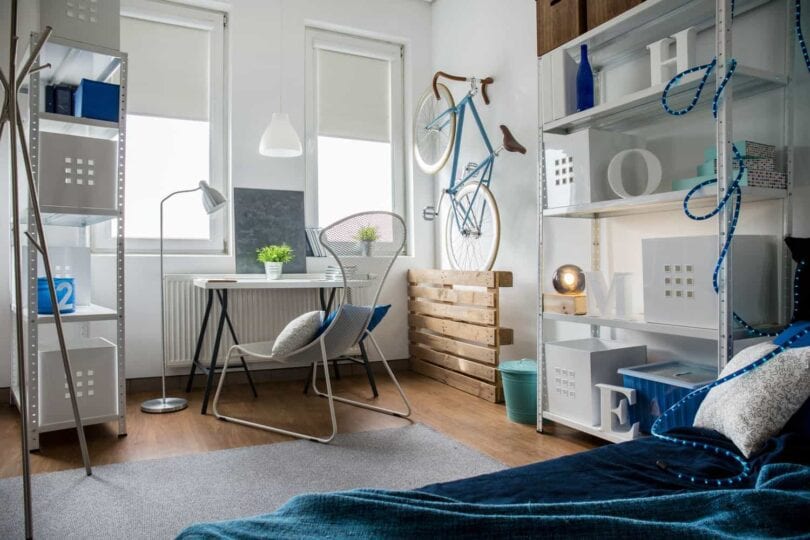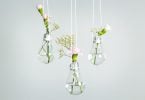Whether in high-rise apartment buildings or the newly-popularized “tiny houses”, many people find themselves looking for clever hacks to make the most of an extremely small space. Contrary to what one might think, living in a small space doesn’t mean you just have to “make do” with next to nothing — check out these clever tips on how to make the most of every inch of space.
1. Get rid of clutter
A cluttered space feels infinitely smaller, and when your floor plan is minimalist, having a clear flow of movement is crucial. When you don’t have extra space, you can’t have unnecessary things scattered about. Routinely take the time to declutter your space to get rid of anything other than the things you’ve established as your essentials. Donate, toss or sell whatever you don’t need, and put items you can’t part with but can’t fit in a storage facility.
2. Get creative — like, really creative
You may not have MUCH space, but you can organize the space you DO have however you want. Who says you have to have a sofa and coffee table? Maybe you’re the kind of person who prefers a hammock, or a whole lot of decorative pillows, or a couple of rocking chairs under a homemade loft bed. You have the ultimate carte blanche to be imaginative about how you feng shui your home. Figure out what you really need and want in your apartment, and work around those essentials to create a cozy space that feels functional for your tastes.
3. The right white
Choosing the right color palette for your small space can make an enormous difference in how big or small it feels. Stick with white or pale hues for the walls — anything too dark will make the room feel small and dark. With your walls in uniform white (or eggshell or ecru or…) you can choose how to artistically add some splashes of color. Wall decals can be a great way to improve the space, particularly if you’re renting. If you have the freedom to paint, adding some focal points of color in certain areas can direct the gaze to make the room feel larger. If you like lighter tones, consider light grays or blues for the details in your room to create a light and airy feel — especially if you don’t have many prominent windows.
4. Use the ceiling to create depth
Choose a darker (but not TOO dark) tone for the ceiling to create the illusion of depth, and add some eye-catching decoration like interesting lamp fixtures or a light-colored mobile to draw attention upwards. Minimalist, cable-based track lighting is one versatile way to light your space effectively by directing light into otherwise dark spaces.
A light colored floor will also help your place feel more spacious. Flooring like bamboo or lighter colored wood will bring a bit of the natural world inside. If you can’t make any changes to your floor (like most renters), a pale colored area rug can be just the ticket.
5. Everything should serve multiple purposes
Small spaces don’t have room for items that only perform one task — and this is where many DIY small-space inhabitants get really creative. From a bed that flips up to reveal storage space (or even goes into the wall), to a desk that doubles as a dining table, to a sink that becomes counter space when you don’t need it, DIY’ers and designers have come up with so many clever pieces of furniture – you just need to decide which ones fit your needs and priorities.
6. Super efficient storage solutions
Once the moving service has dropped off all boxes and furniture from your previous home, many of the newly relocated find themselves scratching their heads: But I thought we downsized! The truth is even the tiniest room has more storage space than you think. Start by maximizing wall space with floating wall shelves and overhead storage space. You can line the perimeter where the walls meet the ceiling with small shelves or build shelves into out-of-the-way corners. Placing things as high as possible will also make the room look taller. Decorative boxes and baskets are also a great way to keep counters and end tables clutter free while maintaining aesthetics — intentionally choose sizes that can slide under the bed, sofa, or end tables.
7. Mirror, mirror, show me more space
Well-placed, decorative mirrors are a great way to trick the eye into seeing more space. Position a large mirror across from a window and it will distribute more light throughout the room as well as create a feeling of spaciousness.
8. Little things are not necessarily better
Contrary to what you may believe, small or miniature items are not the way to go when decorating a small space. One big, comfy couch is better than several smaller chairs and ultimately uses space more efficiently. A large vase gives a better focal point and leaves less unused space than an array of trinkets (see point #1). Larger more functional items keep your space feeling less cluttered.
9. To drape or not to drape
Uncovered windows are the best way to keep the space feeling airy, but if you need curtains for privacy, try using sheers in a light color that will allow light in and while providing a little bit of visual separation. If your drapes are for keeping the sun out, choose lighter colored, full-length curtains that start at the ceiling to make your walls look taller.
10. See it through
Choosing furniture made from glass, plexiglass, or other see-through materials can also create the illusion of space by creating fewer visual breaks in the space. Coffee, end, or dining tables, are prime candidates for utilizing glass, though there are definitely some creative approaches out there for shelving and other furniture!
Bonus: Make the Most of Your Small Space
- Lots of light – In both color choices and lighting options! Painting light colors on walls help to open the space up and feel more spacious. You are less likely to feel super cluttered. Natural light also expands a room’s feel. Utilize all the window space you can, and if not, consider some wall lights or a small ceiling fixture to help enlighten your space.
- Glass and Reflections – Utilize glass décor and mirrors to trick your mind into thinking there is more space in a room than actually exists. Mirrors, specifical floor to ceiling mirrors, cast the illusion that there is more to a room than originally meets the eye. They also allow the light in the room to bounce back and forth. Try glass side tables and other transparent furniture to also prevent rooms from feeling overcrowded.
- Think Vertically – When decorating and creating storage space, remember that a room has 8 corners, not 4. Rather than stacking putting in large storage units, consider mounting shelves or hooks to store items. It adds levels to the room and helps break up walls so there is more to look at, thus, creating a sense of space. Make the walls your canvas and decorate vertically!
For more creative ideas check our blog about tips for maximizing small closet space.








